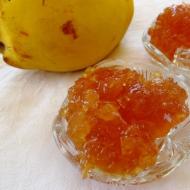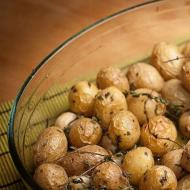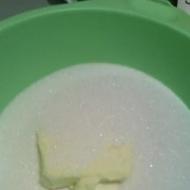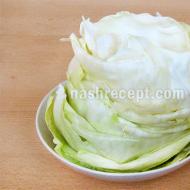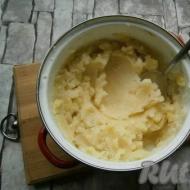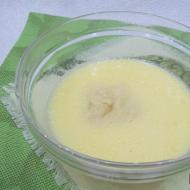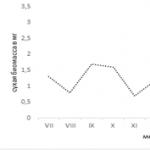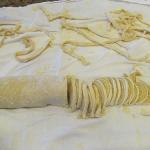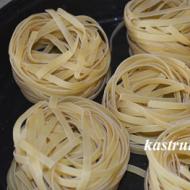
Tomato paste preparations. Tomato paste for the winter. A rustic way to make tomato paste
Tomato paste is used for cooking by millions of people of all nationalities. This is a product known to every housewife in our country, and not only in ours.
Ketchups and sauces are prepared on its basis. In itself, it is not a final product, but a semi-finished product for future dishes. Nobody eats it without first processing it.
It is added to first and second courses to give it a characteristic tomato taste and bright color. And normal, healthy digestion, as we all know, starts with how food looks and smells.
Another thing is winter. Tomatoes are not as tasty, not as sweet. What is their taste and color? And they are not cheap in winter. I don't want to buy it in a store. I once bought a small jar and thought I’d add a teaspoon at a time for color. So it stood open in my refrigerator for three months, and at least it didn’t get moldy or disappear.
What did they mix with the tomatoes? I started reading the ingredients, and I even felt bad, all E-shki. And since I already know everything about these E-shki and even wrote about them. I threw this store-bought product out of harm's way. And I don’t buy it anymore, my own tomato paste, although not so beautiful, but certainly healthy.
According to GOST, pasta should contain only tomatoes and salt. This is how we will prepare it together with you. Of course, pasta may be a strong word. What I get is something between a paste and a juice, neither liquid nor thick. I don’t grind tomatoes through a sieve, and I have it along with seeds. Why waste something good and waste time? Moreover, during cooking there is nothing left of the seeds.
A simple recipe for making tomato paste for the winter
The recipe will be simple. Without any difficulties. Although, if there is a desire to complicate it, I will tell you how this can be done.
We will need:
- tomatoes
- sunflower oil
Preparation:
I don't specifically indicate the quantity. Whoever deems it necessary to prepare will do as much. I always buy one or two boxes of tomatoes. That is, my cooking process is done on an industrial scale.
But I have my own tomato paste in autumn, winter and spring. It tastes like real tomatoes. And if they don’t eat store-bought tomato paste, then just give me this!
Once my husband and I left on business for a week, and my daughter and son-in-law lived at home. Upon arrival, I saw that the jars with it on my shelves had become considerably smaller. And my daughter says: “So your beloved son-in-law fell in love with him, I couldn’t tear him away!” Of course, why not eat it when you eat it, and it’s as if the tomatoes are fresh.
I buy tomatoes at the end of August, when they are the ripest and reddest. Gaining strength from the Sun! Full of juice, taste, vitamins. This is what I cook with.
It's very easy to prepare!
1. Wash the tomatoes, remove the stem, and cut into pieces. So that it is convenient to twist.

2. Twist in a meat grinder. Previously, they turned it manually, it took so long. And now, if you have an electric meat grinder, you can twist everything in an instant.

It also works well if you beat it with a blender in a food processor. Here you can grind it finer or coarser, as you wish.

3. Pour into a large saucepan. And if you have a big cauldron, that’s good too. It is less likely to burn and is easier to stir. The tomato mass does not accumulate in the corners of the pan. If you cook in a saucepan, keep an eye on these treacherous corners and stir often.

4. Don't forget to do this. I stir with a slotted spoon, it grabs well in the cauldron and nothing burns. Cook over low heat. Our preparing pasta should gurgle quietly, not bubble.
This way it will retain its color.
5. While it is cooking, prepare the container where you will prepare it. I store it in glass liter bottles; they remain when you buy different juices. When there are no bottles left, you can use jars with screw-on iron lids. Bottles and jars should be washed well with soda and sterilized.
6. To do this, put water in a regular saucepan and bring to a boil. Place a colander in the pan and place two bottles or jars, bottom up. The evaporating steam must penetrate into the containers. This is how the sterilization process occurs.
Pour boiling water over the lids in a separate bowl and let stand for five minutes. Better yet, boil it.
Can also be sterilized in the microwave. Fast, simple and convenient. Yes, in principle, choose any one. I'll leave a link for anyone interested.
7. We cook for a long time, our task is to evaporate the water. You'll see when it happens. The mass should become thick. Depending on the number of tomatoes, it may take from one and a half to two hours.

Now you especially need to make sure that it doesn’t burn. About 10 minutes before the end of cooking, add salt. Give her the opportunity to break up, try. Don't add too much. You should get the usual salty taste.
8. Heat the oil in a frying pan. We will use it to seal our workpiece.
9. Now is the most crucial moment. We've got everything ready. Take a sterilized jar and place the prepared paste in it with a large spoon, almost to the very edge. Place it tightly, press down with a spoon, making sure there are no air bubbles left.

Now pour a tablespoon of hot oil on top, the oil will spread and form a film. Screw on the lid.
10. If you have prepared bottles, then you need to prepare a funnel. It will make it easier to spread the paste over them. It is thick, will be capricious, and will not want to get into the bottle. But you have to get creative.
Why do I prefer to prepare it in bottles? You only need to pour a little oil, half a spoon is enough. To be honest, I always have a deficit with banks.
I remember how they used to prepare it: they poured it into ordinary glass bottles, and put nipples on top. There were no bottles with lids, and the jars were all being used for other preservation.
11. It is not necessary to turn the jars over; place them on a towel and cover with another towel on top. Let them cool slowly.

As you can see, everything is very simple. But as I warned, it comes with seeds. If you want, you can cook without them. That is, to complicate the recipe somewhat.
If you want to cook pasta without tomato seeds, then you need to grind the cooked paste through a sieve, or squeeze through cheesecloth. And boil for some more time.
Below is a video recipe where I will show you how to do it.
12. Let the jars stand in a visible place for a week, or even two. If you did everything correctly, the workpiece will look normal. And if the technology is violated, it will swell. It may lift the lid, or even knock it out. The contents of such a jar must be thrown out. It cannot be eaten.
Tomatoes have a lot of acid; they themselves are preservatives, so they are not capricious. As a rule, nothing swells. Only if the lid was not tightly screwed on and air could get into the jar.

But I think you will succeed. It is better to store the workpiece in a cool place, away from heating appliances. All apartments have storage rooms. Equip it for workpieces and supplies. Then you will eat tasty and healthy all winter.
Video on how to make tomato paste from tomatoes at home
If you don’t want the resulting tomato to have seeds and small patches of skin, you can cook it without these elements.
It is clear that such a product will be more gentle and pleasant in feel. It will take a little more time to prepare, not for cooking, but for additional processing. Specifically, grinding through a sieve and removing everything unnecessary. But this is not too much time, perhaps only 20 or 30 minutes.
However, see for yourself.
As you probably noticed, here we used absolutely nothing for additives except tomatoes. This is very convenient - when the tomato is salted, and we add it during cooking, then the prepared food can be over-salted.
I used to salt such a preparation, I thought that it would be better stored this way. Then I experimented and found out that it can also be stored perfectly without salt. And now I don’t add salt.
Yes, and I also want to note that you can cook tomato paste until it reaches the thickness you want, right up to store-bought consistency. This is convenient, you will need less containers, and the paste, since it turns out to be highly concentrated, will be consumed more slowly.
By the way, don’t throw away the cake that remains. Put it through a blender along with red hot pepper, add garlic, herbs (parsley, dill, cilantro) if desired, and salt to taste. And the seasoning is ready. You can store it in the refrigerator.

And if you boil it, you can store it like a regular preparation.
Friends, that's all for me.
Cook and eat for your health!
There is hardly at least one housewife who does not use tomato paste to add sourness and bright color to dishes. On store shelves you can find a wide range of this product from different manufacturers.
According to GOST, only tomatoes and salt are used to prepare pasta. Other ingredients in this product are not allowed. Unfortunately, some manufacturers are trying to reduce production costs by adding harmful ingredients such as thickeners, stabilizers, preservatives, dyes, etc. to the semi-finished product. Therefore, despite the abundance of ready-made tomato paste in cans, tubes and other packaging, it is better to prepare your own supply from fresh tomatoes for the winter.
The recipe is so simple that you only need fresh tomatoes and the necessary equipment for any seaming: jars, lids, a key, dishes and a meat grinder. The tomato paste in this recipe does not contain vinegar, salt or any other additives. You can add all this during the cooking process after you open the jar in winter. The tomato paste recipe with photo is the simplest and most basic.
Ingredients
- 2.5 kg ripe round tomatoes.

How to prepare tomato paste for the winter at home
Wash the tomatoes, drain or dry thoroughly. Cut into 4-8 slices depending on the size of the vegetables. 
Grind the tomato pieces in an electric meat grinder. Cook the resulting fresh tomato paste over medium heat. 
The paste should evaporate by half and take on a slightly dark, burgundy hue. Cook for at least 1.5 hours. 
Place two half-liter jars for sterilization. First, wash each of them with a sponge and dishwashing detergent. Rinse off the foam thoroughly under running water. Steam each jar over boiling water. To do this, you can use a colander, a wire rack, or a strong metal sieve. Treat each container with steam for 5 minutes, no more, otherwise the glass may burst. After processing, place the jars close to the stove so that it is convenient to fill them with boiling tomato paste. 
Boil tin lids for sealing. Do this for 5-10 minutes. Be sure to check that each lid has an elastic band in the inner groove, otherwise the seal will swell and spoil very quickly. 
Pour the boiling tomato mixture into jars and roll up with a key. Immediately after canning, turn the jars over. This recommendation applies to any home seaming. 
Cooled jars of tomato paste can be signed on the lids with a permanent marker or covered with homemade stickers. Indicate the name of the sealer and the year of manufacture to constantly monitor the remains of preservation in your home pantry. It is advisable to use this sealing for 2 years, but no more. 
Teaser network
Tips for making tomato paste:
- Use only ripe tomatoes to make pasta. The meatier the tomatoes, the less excess liquid that needs to be evaporated. It's okay if they have defects. They are easy to remove with a knife. To grind, you can use a blender instead of a meat grinder.
- You should not use aluminum cookware for cooking, since this material oxidizes, which means harmful substances get into the food. Do not fill the container to the brim; the paste may foam during boiling.
- If you want the tomato paste for the winter, the recipe for which is given above, to resemble a store-bought product in consistency, then before cooking you need to rub the tomatoes through a sieve or put them through a juicer. That is, it is necessary to get rid of the skin and seeds. The resulting tomato juice is boiled to the thickness you require. As a rule, from 10 liters of juice you get about one and a half liters of paste. It is worth noting that the process is quite long. It is recommended to carry out boiling in 3-5 stages. This paste can be stored not only in a jar, but also in the freezer, packaged in ordinary plastic bags or silicone molds.
- If you are not a fan of long cooking, this process can be significantly shortened. To do this, the squeezed juice must be poured into a linen bag and hung so that excess liquid slowly flows out of it. After about 10-12 hours, place the mixture in a saucepan and boil while stirring. Keep on low heat for 15 minutes and add salt to your taste. There is no need to cook for a long time, since after draining the tomato mass turns out to be quite thick. Place the hot pasta in pre-sterilized jars and seal. Or use the freezer for storage.
How to cook tomato paste in the oven
Tomato paste can be prepared in the oven with salt and spices. To do this, pure tomato juice is mixed with salt, poured into a mold with large sides and placed in the oven. As a form, you can use a high baking sheet or a low wide pan; you can also use any other convenient ceramic or glass forms. Some housewives use two baking sheets at different heights. Oven temperature 220 degrees.
Cook for about 2.5-3 hours, stirring occasionally, until thickened to your desired consistency. Then spices and herbs are added and the cooking process continues for another 30 minutes, after which the paste is placed in sterilized jars and rolled up.
For 2 kg of tomato you need to take 2 tbsp. l. salt, 1/5 tsp. ground black pepper, add some spices to your taste (basil, celery, parsley, dill, cloves, coriander, cinnamon, paprika). You can add fresh greens by first tying them together with thread and removing them at the end of cooking.
We often use thick tomato paste in preparing a variety of dishes.
This product can be found on store shelves all year round, for every taste and from different manufacturers.
But still, can you say for sure what is hidden inside another cute jar of tomato paste?
Are there any dyes and preservatives, thickeners and stabilizers?
Therefore, if you have the opportunity to prepare tomato paste for the winter at home, then it is better to do so.
Try delicious DIY tomato paste recipes at home and take note of the one you like the most.
The principle of preparing tomato paste is to chop tomatoes without skin and evaporate excess liquid from them.
You can do this on the stove, in a slow cooker, and even in the oven.
There is also a little secret in choosing tomatoes: you don’t need juicy, fleshy tomatoes that ripen no earlier than August.
A simple recipe for making tomato paste for the winter
Ingredients:
- tomatoes – 5 kg
- rock salt – 100 g
How to seal tomato paste in jars:
1. Cut the tomatoes into pieces and pass them through a meat grinder or juicer.
2. Pour the resulting mass into a linen bag and hang it over the sink or pan for 8-10 hours.
3. Then transfer the tomato pulp into a saucepan, bring to a boil and cook for 15 minutes.
4. Add salt, stir and cook for the same amount.
5. Transfer to small sterilized jars and seal with lids.
Homemade tomato paste without salt
Ingredients:
- tomatoes - 8 kg
Preserving tomato paste without salt:
1. Cut the tomatoes into 4-8 pieces, place them in a saucepan and put on fire.
2. Cook over low heat for 30 minutes after boiling to soften and allow the skins to come off.
3. Cool and thoroughly rub the boiled tomatoes through a fine sieve to remove the skin and seeds.
4. Place the pan on low heat and cook, stirring occasionally, until the tomato paste begins to “spit” (4-4.5 hours).
This means that the paste at the bottom thickens and sticks to it, so you need to constantly stir it.
5. When the paste reaches the desired thickness, place it in pre-sterilized dry jars.
6. Screw on the lids, turn them over and wrap them in a warm blanket until they cool completely.
Tomato paste with vinegar
Ingredients:
- tomatoes - 3 kg
- bulbs - 2 pcs.
- granulated sugar - 100 g
- vinegar 6% - half a glass
- salt to taste
Preparation of canned tomato paste with vinegar:
1. Cut the prepared tomatoes into halves or quarters and place in a saucepan.
2. Add peeled and chopped onions into large rings to the tomatoes.
3. Pour in half a glass of water, cover with a lid and bring to a boil.
4. Reduce heat and simmer for 15 minutes until the tomatoes release their juice and become soft.
5. Grind the cooled tomatoes and onions through a sieve.
6. Boil the resulting puree over low heat until the volume is reduced by at least 5 times, stirring occasionally so that the paste does not burn.
7. At the end of cooking, add salt and sugar, taste and adjust if necessary. Warm up for a couple more minutes.
8. Pour in the vinegar, stir and immediately pour into sterilized jars.
9. Roll up the boiled lids, roll up, turn over to the bottom and cover with a blanket for a day.
How to make tomato paste with a blender
Ingredients:
- tomatoes
- sugar
Making tomato paste for the winter:
1. Cut the tomatoes into not very small pieces and place them in a saucepan.
2. Place on the fire, boil and cook over medium heat for 15 minutes.
3. Grind the boiled tomatoes with a submersible blender.
4. To ensure that there are no skins or seeds left in the tomato paste, rub through a sieve.
5. Place tomato juice over high heat and bring to a boil.
6. Reduce to medium and simmer to desired consistency for several hours. You need to stir every 10-15 minutes.
7. Add salt and sugar to taste and simmer over low heat, covered, for 3-4 minutes.
8. Pour into sterilized small jars and screw on the lids, you can use screw ones.
Tomato paste directly with seeds in a bag
Ingredients for 5-6 half-liter jars:
- tomatoes – 10 kg
- salt – 2–3 tablespoons
- white, black, allspice, cloves, cumin, cilantro - 1-2 tsp. mixtures
Unusual tomato paste recipe:
1. Grind the tomatoes in a meat grinder with a fine grid or chop with a blender.
2. Boil after boiling for 5-7 minutes over low heat.
3. Hang a clean linen bag, for example, between two chairs with a backrest, over a large basin.
4. Pour the chopped tomatoes into it.
5. After 1.5-2 hours, transfer the resulting tomato paste into a saucepan, add salt and spices, and stir.
6. Let it boil and pour into sterilized jars.

Order an energy saver and forget about the previous huge expenses for electricity
7. Before seaming, the workpiece must be sterilized in low-boiling water for 20-25 minutes.
The liquid that has drained from the tomato can be used to preserve tomatoes instead of water; it will turn out unusual and very tasty.
Tomato paste for the winter with garlic
Ingredients for 2 liter jars:
- 3 kg tomatoes
- 140 g sugar
- 25 g salt,
- 80 ml 6% vinegar
- 2 cloves garlic
- 4 cloves
- 10 black peppercorns
- red pepper to taste
How to prepare tomato paste with garlic:
1. Scald the tomatoes with boiling water, immerse in ice water, then peel and finely chop.
2. Transfer to a saucepan and simmer over medium heat by a third of the volume without a lid.
3. Add sugar, after dissolving it, add salt and keep the pan on the fire a little longer.
4. Add spices and cook for 10 minutes.
5. After cooling, rub through a fine sieve, put the tomato paste back into the saucepan, and bring to a boil.
6. Pour in vinegar, stir, place in sterilized jars and seal.
Delicious tomato paste with apples through a juicer
Ingredients:
- tomatoes - 3 kg
- sour apple - 2 pcs.
- onion - 1 pc.
- vinegar 6% - 30 ml
- salt to taste
How to preserve tomato paste with apple:
1. Tomatoes, apples and onions pass through a juicer.
2. Pour the resulting mass into a linen bag and hang it overnight to drain the liquid.
3. Transfer the thick puree mixture from the bag into a saucepan, add salt and boil for 25-30 minutes.
4. Add vinegar, stir and cook for another 5 minutes.
5. Pour the tomato paste into clean jars, cover with lids and place in a large saucepan with water (the water should be up to the shoulders); sterilize half-liter jars for 10 minutes, liter jars for 12 minutes.
6. Roll up the lids and, turning them over, wrap them in blankets for a day.

Making homemade tomato paste with spices
Ingredients:
- 4 kg tomato
- 300 g onion
- 30 g salt
- 300 g sugar
- 250 ml apple cider vinegar
- 3-4 cinnamon sticks
- 15-20 allspice peas
- 4 bay leaves
- 10 g rosemary
How to preserve tomato paste in jars:
1. Cut the tomatoes into pieces and place them in a saucepan with a thick bottom.
2. Add onion cut into half rings to the tomatoes.
3. Place on the stove and cook for 25-30 minutes until the skins of the tomatoes come off.
4. Cool and rub through a sieve. Place back into the pan.
5. Wrap all the seasonings in cheesecloth and dip into the paste.
6. Bring to a boil, cook for 15 minutes and remove the spice bag.
7. Cook, stirring, until reduced in volume by 3 times.
8. Add salt and sugar, pour in vinegar, and simmer for another 10 minutes.
9. Place in sterilized jars, roll up and leave to cool.
How to cook tomato paste in the oven
Ingredients:
- 2 kg tomato
- 40 g salt
- 60 ml vegetable oil
Recipe for tomato paste in the oven:
1. Chop the tomatoes, boil them for 30 minutes over low heat, cool and rub through a sieve.
2. Mix tomato puree with salt and oil, place on a baking sheet or in a baking dish.
3. Place in a low-heat oven for 2 hours, periodically removing and stirring the mixture.
4. Place in sterilized jars and seal with lids.
Alternatively, this paste can be put into molds and placed in the freezer, and defrosted before use.
Tomato paste in a slow cooker
Ingredients:
- 2 kg ripe fleshy tomatoes
- fine salt
Preparing tomato paste in a slow cooker:
1. Cut the washed tomatoes into slices and place in a bowl (without water).
2. Close the lid, set the valve to the “Closed” position and cook on the “Stew” program for 1 hour.
3. Release the steam, cool the tomato mass and rub it through a sieve.
4. Transfer the puree back into the bowl and set the “Baking” mode for 20-25 minutes, until the volume of the paste is reduced by 2 times.
5. Add salt to taste, mix and place in sterilized jars, covering with lids but not rolling up.
6. Heat water in a wide saucepan for pasteurization to 50 degrees, covering the bottom with a towel.
7. Place the jars in it, bring the heat to 85-90 degrees and let it sit for 20 minutes.
8. Roll up the jars with lids and place them upside down under a blanket until they cool completely.
Recipe for tomato paste with grape vinegar
Ingredients:
- 3 kg tomatoes
- 500 g onion
- 100 ml grape vinegar 3%
- 4 bay leaves
- 50 g salt
- 100 g sugar
How to make tomato paste for the winter:
1. Cut each washed tomato into 6–8 pieces and place in a saucepan with a thick bottom.
2. Peel and chop the onion as you like, add to the tomatoes.
3. Place over low heat and cook until the skins of the tomatoes separate - about an hour, stirring occasionally.
4. Cool and rub through a sieve.
5. Cook again until the mass has reduced in volume by at least three times.
6. Add salt, sugar, bay leaf, pour in vinegar and cook for another 10 minutes.
7. Pour into sterilized jars and seal.
Tomato paste is a truly indispensable product for any housewife. It can be used to prepare borscht, sauces and gravies, for making pizza, etc.
However, the taste and quality of store-bought tomato paste leaves much to be desired. Therefore, I have long planned to learn how to make delicious tomato paste at home. And finally I found a recipe for a truly tasty and healthy pasta.
To prepare tomato paste you need:
- 3 kg – ripe tomatoes
- 1 small – onion
- 3 tsp – sugar
- 2 tsp – salt
- 3 pcs. – bay leaf
- 1 tsp – apple cider vinegar
- spices - to taste
Recipe for homemade tomato paste:
The main thing in preparing delicious pasta is to choose the right tomatoes. Tomatoes must be ripe, as even a few unripe fruits can completely ruin the taste of your tomato paste.
Place water in a large saucepan on gas and bring to a boil. Meanwhile, wash our tomatoes. Place them in a pan with boiling water and leave for about 5 minutes. After this, remove the skins from the tomatoes, and also remove any black spots and other defects (if any).
We cut the tomatoes into slices and remove the seeds with excess juice - we only need the pulp. Place the prepared tomatoes in a saucepan, place over medium heat and cover with a lid. While the tomatoes are boiling, peel and finely chop the onion.
Add the finished onion to the pan and bring everything together to a boil - it will take about 15 minutes. When the tomatoes have boiled, drain the juice. Within 15 minutes, the procedure for draining the juice will have to be repeated a couple more times - i.e. our tomatoes have been on the fire for 30 minutes.
Now remove them from the heat and turn the mass into puree. To do this, you can use a food processor, blender, regular fork or meat grinder. Add sugar, salt, bay leaf and your favorite spices to the finished puree.
For spices, you can add dried dill and ground black pepper, you can also add a couple of black allspice peas. Next, we continue to cook on almost minimal heat, while we need to make sure that our tomato puree slowly boils, but does not burn.
The lid should be kept slightly open to allow moisture to evaporate. To avoid burning, you must stir periodically, but very carefully, because the paste splashes painfully. At the end of cooking, add apple cider vinegar; it is better to remove the bay leaf and discard it.
As a result, three hours after grinding the tomatoes and adding spices, we get a tasty and healthy homemade tomato paste. Three kilograms of tomatoes yield approximately 500 ml of paste. We pack the finished paste into sterilized jars.
You can sterilize jars like this: boil a third of a pan of water, put a splash cover on top for the pan and place the jar. We boil for about 15 minutes. You can also check the readiness of the jar by drops: they should become large and begin to drain. We simply boil the lids in the same water for about 10 minutes. We put the paste into jars and close.
How to store tomato paste?
To preserve tomato paste without a hermetically sealed seal, it should be salted before the end of cooking (at the rate of 100 g of salt per liter jar). To prevent tomato paste in an open jar from becoming moldy, sprinkle it with salt and cover it with a thin layer of vegetable oil. You can also sprinkle with dry crushed horseradish leaves. .
Any homemade tomato paste will be much better than store-bought for several reasons:
- naturalness of the products used;
- confidence in taste qualities, their correction according to one’s own preferences;
- high final quality.
If you follow some recipes, the pasta can also be used as a sauce.
Tomato paste according to the classic recipe
Tomatoes should be firm, fleshy and elastic.
The ideal variety is “Slivka”.
- They are washed, and their damaged areas are removed with an ordinary knife.

- Then the tomatoes are cut in half, placed in an enamel bowl, and topped with chopped onions.


- Next, water is added in an amount of 125-150 g.

- The workpiece is covered with a lid, brought to a boil, after which the heat on the stove must be reduced to allow the contents to simmer for 10-15 minutes. It’s very easy to check for readiness - the tomatoes release their juice and become very soft.

- After cooling, the mass is ground through a sieve.

- It is boiled over low heat for some time until its volume becomes 5 times less than the original. To prevent the pasta from burning, it is important to stir it.

- Salt (to taste) and sugar are added at the very end. It is important here to adjust the taste by constantly tasting the pasta. As soon as it is brought to the required taste, you need to add vinegar, mix well, and then pour into sterilized jars, which are immediately sealed with lids.

After this, they are turned upside down, and until they cool completely, they hide under a warm blanket, and then go to the cellar or pantry.
The pasta prepared according to this recipe can be opened at any time as needed.
Video on preparing traditional tomatoes for the winter:
Cooking method in a slow cooker
With the advent of multicookers, any dish can be prepared with minimal time and effort, since this device is a hybrid of a steamer, bread maker, pressure cooker and a regular saucepan.
Tomato paste is no exception, which housewives prepare at home according to a recipe for long-term storage.
To make it you will need the following ingredients:
- tomatoes – 1.5-2 kg;
- vegetable oil – 2 tablespoons;
- salt – 1 tablespoon;
- 70 percent vinegar - 2 teaspoons;
- sugar - a tablespoon.

The tomatoes are washed and peeled.
All flaws are removed.
Then they should be grated using an ordinary grater, or scrolled in a blender.
You don't have to remove the seeds - it's a matter of taste.
By using watery tomatoes, you can avoid adding water.
Sugar and then salt are poured into the prepared mass, after which it must be mixed thoroughly.
Afterwards you need to pour vinegar and oil into the preparation.
If you wish, you can add some spices, for example, ground pepper.
The future paste is thoroughly mixed again.
The mixture is placed in a multicooker, which is turned on in the “quenching” mode for 1 hour.
Interestingly, the mixture does not burn in the slow cooker, since it is stewed gradually, however, it is necessary to stir periodically.
After 1 hour, the workpiece can be rolled into jars.
This is done in exactly the same way as when cooking according to the classic recipe.
Spicy tomato paste in the oven
Not every housewife has a multicooker.
However, you can cook an equally tasty version in the oven, and even using spices.
For this you need:

The tomatoes are washed and spoiled areas are removed.
They must be placed in a large sieve placed over an appropriately sized pan of boiling water.
The mixture is boiled for 10 minutes.
It is advisable to divide the tomatoes into several batches so that they are better cooked over steam.
The softened tomatoes are rubbed through a sieve, and the mass mixed with salt is poured into a saucepan with high sides and sent to an oven preheated to 200 degrees.
 While the tomato is simmering on the fire, you can prepare a pear pie for tea, which, due to its ingredients, has a delicate consistency.
While the tomato is simmering on the fire, you can prepare a pear pie for tea, which, due to its ingredients, has a delicate consistency.
Returning to winter preparations, I would like to offer you more cabbage salads. Enrich your winter diet with vitamins!
And on our website there are various options for preparing lecho from bell pepper. All the details
The paste will cook for about 2 hours, and during this time it needs to be stirred periodically, paying attention to the thickness.
Spices are added after the required consistency is achieved.
Herbs, previously tied into a bouquet, are also sent into the mass at the same time.
The mixture is prepared for another 30 minutes, after which the greens, which have lost their beneficial properties and taste, are removed.
The preparation is poured into sterilized jars, which are sealed.
They are covered with blankets and turned upside down.
Store until completely cooled (preferably within 24 hours).
So you have become familiar with popular cooking methods, and now take a little time and look at the universal “5 in one” recipe:
Secrets of preparing and storing homemade tomato paste
If you follow the following cooking rules, the pasta will turn out much tastier than the store-bought version:
- if you use watery tomatoes, you don’t need to add water;
- all spices are added to the mass only after it boils;
- Before adding, all the greens need to be tied into a bunch (this will make it easier to remove them from the almost finished workpiece);
- To prevent the mixture from burning during cooking, it is important to stir it;
- salt is always added depending on personal taste preferences.
The paste can be stored at room temperature.
The main condition is absolute tightness.
Otherwise, air trapped inside will cause the lid to swell, and the winter preparation will become unsuitable for consumption.
Some more tips in the video below:


